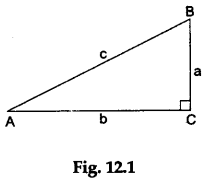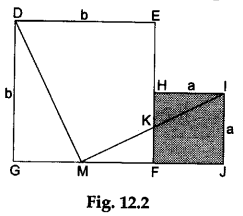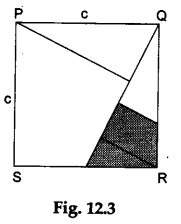Math Labs with Activity – Pythagoras theorem (Method 4)
OBJECTIVE
To verify Pythagoras’ theorem (Method 4)
Materials Required
- A piece of cardboard
- Two sheets of white paper
- A pair of scissors
- A geometry box
- A tube of glue
Theory
Pythagoras’ theorem: In a right-angled triangle, the square of the hypotenuse is equal to the sum of the squares of the other two sides.
Procedure
Step 1: Paste a sheet of white paper on the cardboard.
On this paper, draw a right-angled triangle ABC, right angled at C.
Let the lengths of the sides AB, BC and CA be c, a and b units respectively (see Figure 12.1).

Step 2: On the other sheet of paper, draw three squares—one with each side measuring a units, another with each side measuring b units and the third with each side measuring c units. Cut these three squares.
Step 3: Place the squares having sides a units and b units together as shown in Figure 12.2.
Step 4: Label the diagram as shown in Figure 12.2. Mark a point M on the side GF of the square DEFG such that GM = a units. Join DM and MI. Let MI cut the side EF of the square DEFG at K.

Step 5: Separate the two squares. Cut the square DEFG along the lines DM and MK. Cut the square HIJF t along the line KI. Thus, we get two quadrilaterals and three triangles.
Step 6: Arrange these two quadrilaterals and three triangles over the square c PQRS with each side measuring c units as shown in Figure 12.3.

Observations and Calculations
We observe that the two quadrilaterals and the three triangles can be arranged (as in Figure 12.3) so as to completely cover the square PQRS.
∴ area of the square PQRS=area of the square HIJF + area of the
square DEFG
i.e., c²=a² + b².
Therefore, the square of the hypotenuse of the right-angled AABC is equal to the sum of the square of the other two sides.
Result
Pythagoras’theorem is verified.
Math Labs with ActivityMath LabsScience Practical SkillsScience Labs
